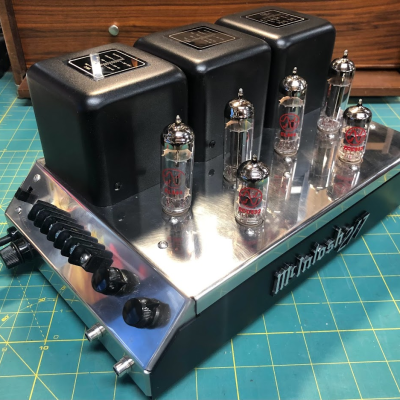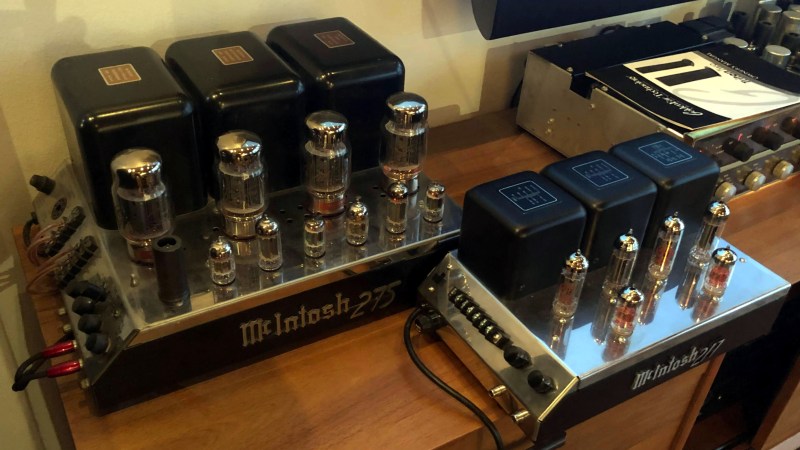It’s not every day we see the results of someone putting their own spin on a vintage tube amp, but that’s exactly what [lens42] did in creating the McIntosh 217, created as a “mini” version of the McIntosh MC275, a classic piece of audio equipment. Both are pictured next to each other, above.
 When it comes to vintage hi-fi stereo amplifiers, two units had particular meaning for [lens42]: the McIntosh MC275 Power Amp, and the Dynaco ST35. The Dynaco was a more budget-friendly amplifier, but looked like a plain box. The McIntosh, however, proudly showed off its tubes and transformers in all their glory. The “McIntosh 217” is design-wise basically a smaller McIntosh MC275, with the innards of a Dynaco ST35.
When it comes to vintage hi-fi stereo amplifiers, two units had particular meaning for [lens42]: the McIntosh MC275 Power Amp, and the Dynaco ST35. The Dynaco was a more budget-friendly amplifier, but looked like a plain box. The McIntosh, however, proudly showed off its tubes and transformers in all their glory. The “McIntosh 217” is design-wise basically a smaller McIntosh MC275, with the innards of a Dynaco ST35.
With so much needing to be designed from the ground up, CAD was invaluable. Component layout, enclosure design, and even wiring and labeling all had to be nailed down as much as possible before so much as heating up the soldering iron. Even so, there were a few hiccups; a vendor had incorrect measurements for a tube socket which meant that the part would not fit. A workaround involved modifying the holes and as luck would have it, the change wasn’t an eyesore. Still, [lens42] reminds us all that whenever you can, have the required parts in-hand for confirmation of dimensions before sending CAD files off for cutting or fabrication.
Many of us can relate to the fact that the whole project was a labor of love and made no real financial sense, but the end result is fantastic, and creating such a thing is something all of us — not just chasers of that elusive “tube sound” — can appreciate.
















great job!
Shouldn’t the filaments be grounded through a potentiometer (ends to filament supply, wiper to cathode bypass) to allow optimizing for minimum noise coupling?
Or just isolated: the filaments are just heaters here, should not be connected to anything but their own supply — I wonder why the cathodes of the output tubes are wired to the filament supply.
The potentiometer is the better solution as the coupling between the filaments and cathode (however small) is differential and can be adjusted. It seems fairly minor but if you are balancing and setting up a tube amplifier with a distortion meter you can see a null in hum and noise as you adjust the filament balancing pot. A better solution is to rectify and filter the filament supply or even better to have a soft start ramp up on the filament voltage to avoid turn-on current inrush which is the primary cause of premature filament failure.
As a proud owner of 2 MC 20s, I want to say “good job”. Nicely done.
I didn’t see where he’s using one of those $300 wall sockets with oxygen free copper contacts that I’ve seen advertised for audiophile use.
Bwahahahahahhaa. Why would that be useful in any way? More likely to get dirty power no matter where you plug it in, short of cleaning the power through a battery and buuilding or buying a high quality power supply, there is no use in adding copper to the plug as the power coming in switches from aluminum to steel to copper to brass and back on the way into the house god knows goe many times. Aluminium drop from the street, to whatever is in your power meter, back to aluminum, then to the breaker box which has who knows what on the breaker, to copper on the in house lines, then to the outlet, where it makes final contact with the plug to your copper wires. Changing the material at the last point of contact seems… pointless.
The marketing department doesn’t care about pointlessness. Especially when gullible people are so easily convinced about the hype they read.
Case in point: Monster Cable products, such as gold plated RCA plugs and some special thingamajig crap braided cables. People read it and gladly fork over the cash.
I have a friend who would pay the extra cash for stuff like that. Took him to an electronics supply store about half hour away, one of the very few still left that you can go in and walk out with things such as transistors, caps, tech books, ham stuff etc, and while he was walking to the register I asked a guy nearby who just happened to be an electronics engineer what he thought about the cables my buddy just had to have,,”those? They’re overly expensive crap”.
My friend still bought them…
I totally agree w/you and the EE. Many consumers (of most ANYTHING) believe that ‘Paying More’ assures the buyer of a better product…to which I must add one of the most profound of MURPHY’S LAWS….
“IT IS MORALLY WRONG TO ALLOW
SUCKERS TO KEEP THEIR MONEY”
But do those smaller tubes actually produce the same warm sound?
Btw: I’ll never get over my disapproval for metal cases around high-voltage electronics. I know it’s perfectly safe as long as everything works as expeced, but always feels like a wildly unnecessary risk.
No a risk is a Class II device which can happily keep humming along during a fault, relying on insulation rather than a form of active protection.
I’ll take a grounded chassis and an outlet protected by an RCD (GFCI) around high voltage electronics any day.
Why not get a fancy arc fault with gfci? Oh thats right, they are expensive af.
Because they are SHOCKINGLY good at letting you know when you have an issue just by touching it. :-P
Nuclear take: audiophilia can be reduced almost ENTIRELY to how many watts RMS you can output before clipping comes in. Nobody really notices or gives a shit about any other quality and only pretend to do so to psychologically justify the fact that they spent as much on their record player as their house.
The thing that most people get satisfaction from in double-blind tests is simply whichever setup can put out more watts before making breaky/explodey noises
[lens42] sez: “It would have been great to have the panel fiber-laser marked before bending, which would have given me nice dark permanent letters, but alas, I found no vendors that offered this.”
Try Protocase https://www.protocase.com/ Fantastic service.
Don’t see point to point wiring needing a cad design, schematic is sufficient, ditto for the chassis. Reasonably close is good enough, remember, this is supposedly RETRO
Yeah, use a pencil and paper to draw up the circuit diagram. Pfftttt, cad is for millenials. :-P
Preferably taped to the inside of the chassis and half-eaten by silverfish for the full effect. I love finding those.
So he took a different low tier product and put it in the case of a higher tier product ?
What a beautiful build! Clearly a labour of love.
Part of the magic of those old tube amps were the interactions with the speakers of the same period they were mated with (Altec, Klipsch, Wharfedale, Electro-Voice, etc). I wonder what speakers the builder is using.
Part of the (expensive) magic of those old tube amps is the darned output transformer.
For just about everything else, you can find a modern equivalent that works as well or better, but nothing can replace that heavy, large and expensive chunk of iron and copper. You can conjure up active designs that kinda-sorta do the impedance transformation in special cases, but even those require transformers, albeit smaller ones.
Pipe up if you know of a replacement for a transformer, particularly if it will operate at several hundred volts and also pass the DC plate current.
Yes. You can use other transformers, but lose the bandwidth.
Power transformers can be rewound for different voltages. There was once a PA in Popular Electronics that used a CA3020 and needed an odd output transformer. So they showed how to rewind an existing transformer. But that was voice, limited range.
Ironically, one source of suitable transformers is existing amplifiers, but then you’re better off rebuilding the amp.
I said that old tube amps had “magic”. I didn’t say they were better ;-) And their low output power was not an issue because of the greater efficiency of many older speaker designs. (ported, labyrinth, horns, etc)
Like I said, I’m curious to know what speakers the builder used with this amp, and with what success.
AIUI, The builder is Borg, the Amp is wired direct.
Hammond Mfg in Canada is a fairly big maker of transformers for different purposes. At work I’ve used bushels of their line-level audio transformers. They apparently also make a line of tube interstage and output transformers for audio:
https://www.hammfg.com/electronics/transformers/classic#tube-audio-output-push-pull
Try Lundahl Transformers (https://www.lundahltransformers.com/). I got a replacement output transformer for an old tube amp from them, and was very happy with it.
Failing that, look for UTC “Ultralinear” audio transformers on ebay. Expensive, but good stuff!
Ooh! Thank you! I will check them out!
If you dance enough, it might warm you up a bit, but I doubt those power tubes and transformers are going to be anything but luke warm at 17.5 watts per channel. I live north of Maine, and my power amp running 4 6L6s still has the fn come on in january.
That’s just the output power, right? I’d think this thing definitely consumes more than 35 watts.
A poor quality amplifier can have excessive hum or other noises that are irritating at low levels. Most speakers have lousy low frequency response. A poor tuner or inadequate antenna mean excessive noise and distortion or no audio at all.
The shame is that most reviews are effete nonsense with no technical testing at all. Much equipment comes nowhere near to meeting its power rating and that failure is seldom mentioned.
Oh for the days of Hirsh-Houck Laboratory!
nicely done, but petty nitpicking in the off-site article, but scaled down 85% is not the same as 85% smaller.
“Sitting next an MC225. The amp is about 85% smaller in each dimension and weighs about 1/2 of an MC225.”
Not that I could do anything as well
… also Alpha control pots are guitar level stuff, not hifi audio quality, for line level control. All that work and a pair of ±20% cheap pots?
Other than that it’s beautiful
Not trying to put anyone down, but to me, tube amps are for instrument amplification that’s when you want the tubes distortion. For stereo’s, I like an amp with no distortion at all. It should get out of the way and simply amplify the signal. Otherwise you are changing what the artist made. But I’ve only been playing and listening since the 60’s. I still love my pioneer 160 wpc with almost no distortion from 76.okay,tear me up, it’s only my opinion
Therefore sitting in warm lounge listening to the best sounding music!